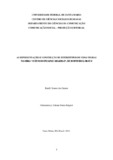| dc.contributor.advisor | Brignol, Liliane Dutra | |
| dc.creator | Santos, Katiéli Soares dos | |
| dc.date.accessioned | 2020-11-25T13:53:01Z | |
| dc.date.available | 2020-11-25T13:53:01Z | |
| dc.date.issued | 2019 | |
| dc.date.submitted | 2019 | |
| dc.identifier.uri | http://repositorio.ufsm.br/handle/1/20170 | |
| dc.description | TCC (Graduação) - Universidade Federal de Santa Maria, Centro de Ciências Sociais e Humanas, Curso de Comunicação Social Produção Editorial, RS, 2019. | por |
| dc.description.abstract | This corse conclusion paper intends to identify the representations and the construction of stereotypes of black people shown in the children’s novel “Yellow Woodpecker’s Ranch” written by Monteiro Lobato. As author and editor Monteiro Lobato was responsible for writing, editing, publishing and distributing his works throughout Brazil. The books, published between 1921 and 1947, about the adventures of some children in their grandmother’s ranch, aimed to promote various elements of the Brazilian culture for the young public. His stories were passed by many generations and was adapted into different formats including a television series. The starting point of this research is: how to analyze the Yellow Woodpecker’s Ranch by insights about the racial issues in a way that investigates how the representation and construction of stereotypes of the black population are related to the structural racism in the Brazilian society. In order to answer these questions this research tries to contest the representation of black people, the role that they play in Monteiro Lobato’s children stories, categorize how the oppression towards black people happen in his work and, by that, reflect how deep the structural racism is present in the stories. This paper is based on documented and bibliographic research and it also analyzes the content of four selected stories. As some of the main results we observed that his work has many racist elements that included, for example, the characters refer to one woman as big lip nigger and the narrator comparison a black character to a monkey. The racism present in Monteiro Lobato's work is shown in its structure and by how he represents black characters, using stereotypes of "good negro" and pejorative use of the word "negro/nigger/black", having as well many references to the slave period, and demotion of the black culture in comparison to the European culture — as the black culture is seemed as inferior and the European as superior. Therefore is of extreme importance to assume that the author, his works and declarations are racists and that if this fact is denied the development of a anti racist education is harmed. | eng |
| dc.language | por | por |
| dc.rights | Acesso Aberto | por |
| dc.rights.uri | http://creativecommons.org/licenses/by-nc-nd/4.0/ | * |
| dc.subject | Racismo estrutural | por |
| dc.subject | Sítio do picapau amarelo | por |
| dc.subject | Representação e estereótipos | por |
| dc.subject | Structural racism | eng |
| dc.subject | Yellow woodpecker's ranch | eng |
| dc.subject | Representations and stereotypes | eng |
| dc.title | As representações e construção de esteriótipos de vidas negras na obra "O Sítio do Picapau Amarelo", de Monteiro Lobato | por |
| dc.title.alternative | Representations and stereotypes of black people in Monteiro Lobato's “Yellow Woodpecker's Ranch" | eng |
| dc.type | Trabalho de Conclusão de Curso de Graduação | por |
| dc.degree.local | Santa Maria, RS, Brasil | por |
| dc.degree.graduation | Comunicação Social Produção Editorial | por |
| dc.description.resumo | A presente monografia busca identificar nos livros que formam a obra infantil “O Sítio do Picapau amarelo”, criada por Monteiro Lobato, representações e construção de estereótipos de personagens negras nas histórias. Como autor e editor, Lobato foi o responsável por escrever, editar, publicar e distribuir suas obras por todo o Brasil. Os livros, publicadas entre 1921 e 1947, que acompanham as aventuras de crianças na propriedade rural de sua avó, buscam promover diversos elementos da cultura brasileira para o público infantil. Atravessaram gerações e receberam inúmeras adaptações, inclusive no formato de série televisiva. O ponto de partida para o estudo é o problema de pesquisa: “como analisar a obra do sítio do Picapau Amarelo, a partir de reflexões sobre problemáticas raciais, de modo a investigar como as representações e a construção de estereótipos da população negra estão relacionados com o racismo estrutural da sociedade brasileira”. Para respondê-lo, a pesquisa busca problematizar as representações de pessoas negras, a posição que elas ocupam nas histórias infantis de Monteiro Lobato e categorizar as formas que as opressões contra os personagens negros ocorrem na obra, para, enfim, refletir sobre como a dimensão estrutural do racismo manifesta-se na obra. Além de pesquisa documental e bibliográfica, o trabalho é construído com base na análise de conteúdo de quatro obras selecionadas. Como principais resultados, observamos que a obra contém muitos elementos racistas que vão além das ofensas proferidas pelas personagens e pelo narrador. O racismo na obra de Lobato está em toda a sua estrutura e na forma que representa as personagens negras, trazendo os estereótipos da “Boa negra” e do “Bom negro”. Além de usos pejorativos da palavra negra(o)/preta(o), há diversas referências ao período escravocrata, além de ocorrer o rebaixamento das culturas negras em comparação com a cultura europeia. Portanto, torna-se de extrema importância assumir que o autor, sua obra e suas declarações são racistas e que negação desse fato prejudica o andamento de uma educação antirracista, tão necessária para desmontarmos essa estrutura que vivemos. | por |
| dc.publisher.country | Brasil | por |
| dc.publisher.initials | UFSM | por |
| dc.subject.cnpq | CNPQ::CIENCIAS SOCIAIS APLICADAS::COMUNICACAO | por |
| dc.publisher.unidade | Centro de Ciências Sociais e Humanas | por |



